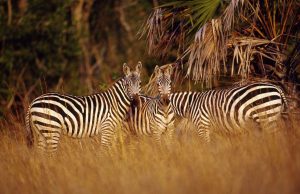
Saadani National Park
A calming coastal breeze blows through the palm trees. Under the tropical heat, white sand and blue ocean glitter seductively. Swahili fishermen cast their nets
As soon as the plane lands, the game viewing begins. Alongside the runway, a giraffe races, all legs and neck, but oddly graceful in its awk wardness. Following the giraffe across the runway is a line of zebras. The greatest population of elephants in an East African national park, Ruaha’s 10,000 elephants create a protective huddle around their young in the distance, behind a bulbous baobab tree.
Ruaha safeguards a sizable portion of the rough, semi-arid bush country that distinguishes central Tanzania, second only to Katavi in its sense of untamed wildness but far more accessible. The Great Ruaha River, its lifeblood, rushes along the eastern boundary during the height of the rains in a flooding torrent before shrinking to a scattering of priceless pools surrounded by a dazzling sweep of sand and rock. A single network of game viewing routes follows the Great Ruaha and its seasonal tributaries, where impala, waterbuck, and other antelopes risk their lives in search of a sip of water that will keep them alive throughout the dry season. In addition to the large prides of lion that rule the savannah, there is also a significant risk from cheetahs that prowl the open grasslands and leopards that hide in dense riverine undergrowth. The presence of striped and spotted hyena, as well as numerous prominent packs of the critically endangered African wild dog, adds to the astonishing variety of huge predators.
Because of its location at the intersection of the miombo forest belt of Southern Africa and the East African acacia savannah, Ruaha has an extraordinarily high diversity of antelope. Grant’s gazelle, lesser kudu, sable and roan antelope, as well as one of East Africa’s largest populations of greater kudu—the park’s emblem—may be found here at the very southern end of their ranges. The males can be identified by their magnificent corkscrew horns. A similar dichotomy can be seen in the 450 bird species on the checklist: central Tanzanian endemics like the yellow-collared lovebird and ashy starling coexist in Ruaha with species like the crested barbet, a beautiful yellow-and-black bird whose constant trilling is a sound of the southern bush.

A calming coastal breeze blows through the palm trees. Under the tropical heat, white sand and blue ocean glitter seductively. Swahili fishermen cast their nets